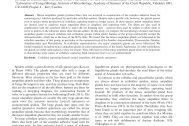Obsah
Minor ampullate glands produce fibers that are involved in construction of the complex adhesive band for capturing prey, which is produced by particular cribellate spiders. Despite such a specific role, however, the glands persist even in species where production of cribellate capturing bands no longer occurs. In these species, minor ampullate fibers are instead used to reinforce major ampullate fibers in draglines and capturing webs. The fibers are also used in combination with the aciniform fibrils to make silk for bridging lines – airborne lines used by spiders to allow them to move to points on the substrate where these threads adhere. In this study, we compare the morphology of minor and major ampullate glands in related cribellate and ecribellate groups within spider families of the group traditionally termed the Amaurobioidea, which lies at the base of the RTA clade. We found that the minor ampullate glands are bifurcated in the cribellate members of this group, in particular in the representatives of the families Amaurobiidae, Titanoecidae, Desidae, Amphinectidae and Phyxelididae. In ecribellate representatives, the major ampullate glands are never bifurcated. We found irregularly branched minor ampullate glands in some representatives of the family Agelenidae. In other ecribellates, the glands are either unbranched or they are absent. Thus, bifurcation of the minor ampullate gland seems to be important in determining some aspect of cribellate capturing band formation that is as yet undetermined.



